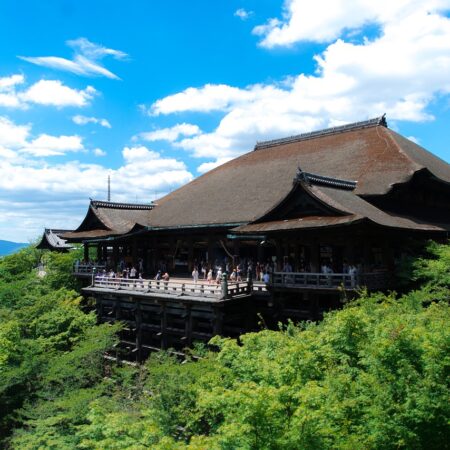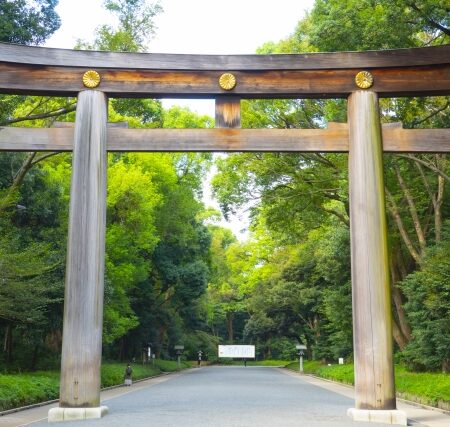Have you ever visited Asakusa? The Kaminarimon Gate is impressive, and Asakusa is one of Japan's top tourist destinations. Many people visiting Tokyo for the first time make Asakusa their first stop. Today, it attracts countless tourists not only from Japan but also from around the world. Do you know what kind of place Asakusa is? Why is the Kaminarimon Gate so famous? This time, we will introduce the history, highlights, and trivia of Asakusa, which is surprisingly not well-known!
The History of Asakusa
First, let's look at the history of Asakusa. Asakusa is a region with a long and rich history, so let's trace how it has developed over time.
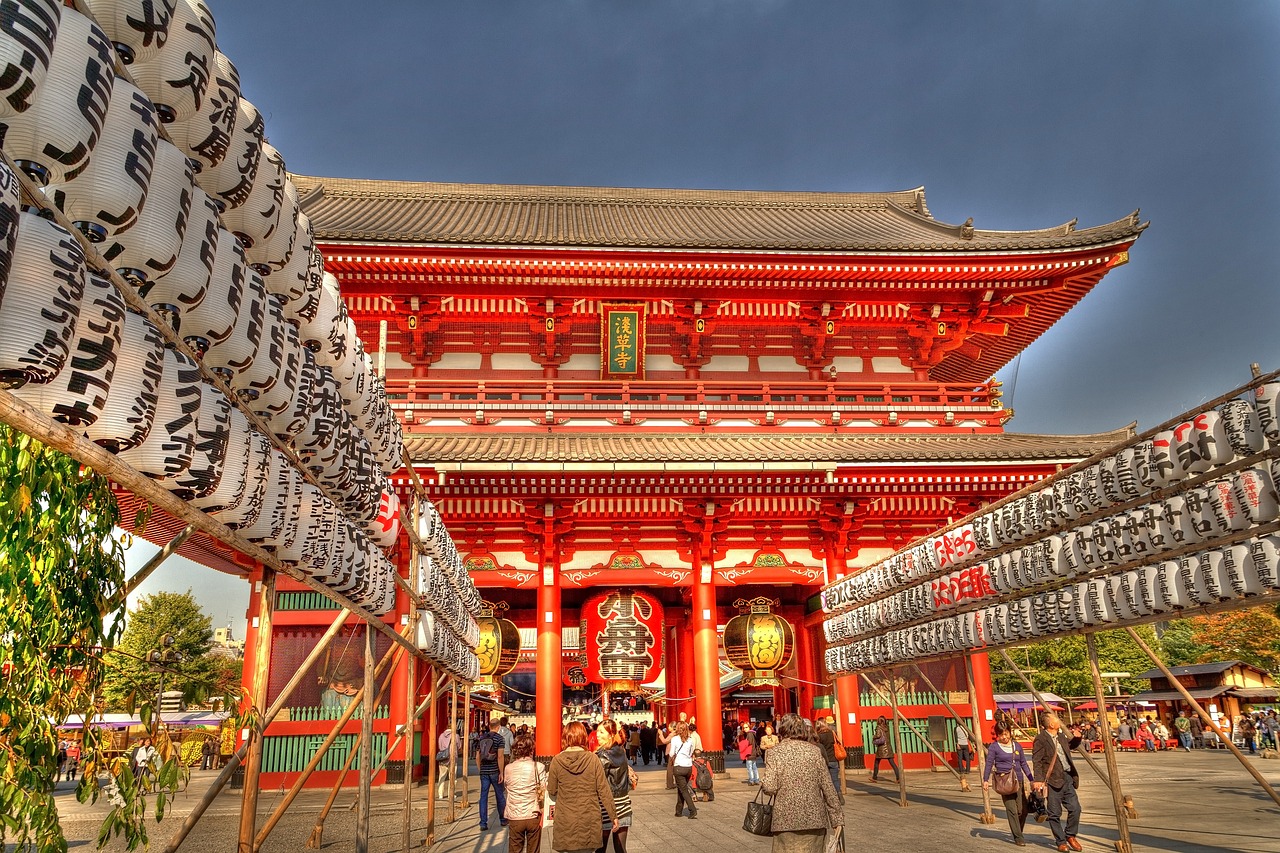
Asakusa, located near the mouth of the Sumida River (formerly known as the Furumagawa), has enjoyed the blessings of the sea since ancient times. The area around Sensoji Temple, including places like Matsuchiyama, Bentenyama, Kuramae, and Torigoe Shrine, lies on the slightly elevated Asakusa Plateau. This region has been relatively safe from flooding and has been steadily turning into land since ancient times.
One of the most notable events in Asakusa's history is the founding legend of Sensoji Temple in 628. During the reign of Empress Suiko, two fishermen, the Hinokuma brothers Hamanari and Takenari, are said to have pulled a statue of Kannon from the Sumida River with their net. They worshipped and enshrined the statue, marking the beginning of Sensoji Temple. This event symbolizes the moment when Asakusa began to play a central role in religious devotion.
Additionally, Asakusa was known as Asakusa Minato since ancient times and was an important port leading to the interior of Musashi Province. It was located in Ishihama (present-day Hashiba in Taito Ward) and Imazu (present-day Imadocho in Taito Ward) and served as a key transportation hub, with official roads connecting Musashi Province and Shimosa Province. These geographical features provided the foundation for the town's development. In the medieval period, the area around the Sumida River became the boundary between Musashi Province and Shimosa Province, further increasing its significance. Notably, the stretch from Asakusa to Ishihama saw the construction of Ishihama Castle, contributing to the region's defense.
It significantly developed during the Edo period due to the rice warehouses
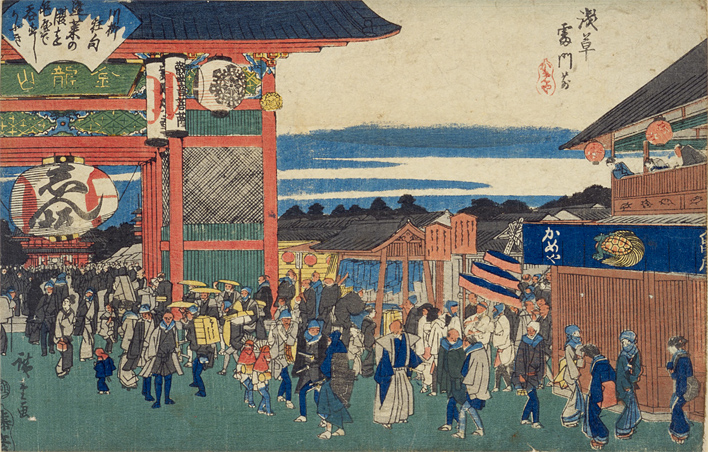
During the Edo period, Asakusa reached a significant turning point and rapidly developed. One major factor in this development was the establishment of the Asakusa Okura (present-day Kuramae district), a rice warehouse. This warehouse was a crucial facility for storing rice collected from all over Japan, which was used for the consumption of samurai and Edo commoners, as well as for the salaries of samurai working in the castle. Rice played an important role in the economy at the time, and this warehouse was akin to a treasure house.
The management and distribution of rice involved merchants known as "fudasashi." The fudasashi were responsible for managing the rice they held in trust and distributing it as cash or rice to the samurai. They charged a fee for this process, which allowed them to make significant profits. Furthermore, the fudasashi often lent money to the samurai with interest, leading many fudasashi to become very wealthy.
Asakusa became known as a place of luxury for the fudasashi and emerged as a cultural center of Edo. Especially after the Great Fire of Meireki in 1657, when the Yoshiwara pleasure district was relocated from Nihonbashi Yoshicho to Asakusa, the area's prosperity further accelerated. Additionally, in 1841, after several theaters burned down, the Edo theaters were consolidated in the Rokuchome district of Asakusa, establishing it as a theater town.
(Image Citation: 錦絵で楽しむ江戸の名所)
Since the Meiji era, it has developed as a cultural hub centered around cinema.
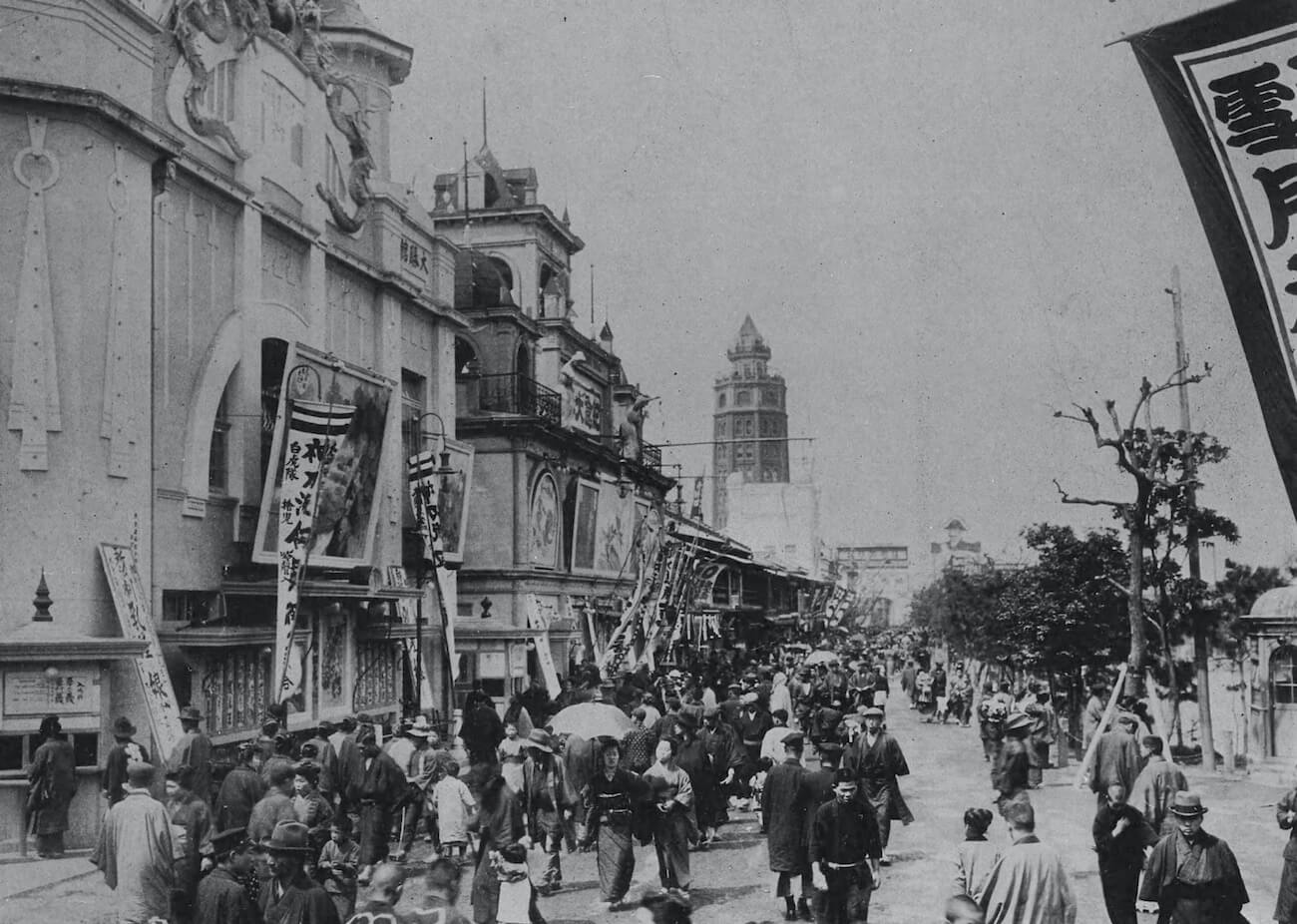
Entering the Meiji period, Asakusa's development entered a new phase. The construction of the 12-story Ryounkaku Tower, along with new entertainment venues and theaters, established Asakusa as a cultural hub representative of Tokyo. However, the Great Asakusa Fire of 1921 and the Great Kanto Earthquake of 1923 caused significant damage to much of the city. After the earthquake, the entertainment industry saw the full-fledged entry of Shochiku, and competition with Toho intensified in the early Showa period. Although Asakusa continued to thrive as an entertainment center, issues of public morals led to increased government regulations. The proliferation of movie theaters and the development of transportation networks also changed the landscape of Asakusa. The immense popularity of movies earned Asakusa the nickname "the town of movie theaters."
Post-World War II, Asakusa underwent new development alongside its recovery from war damage, continuing to attract many people as one of Tokyo's cultural and tourist centers. During the postwar recovery period, the area around Sensoji Temple, as well as Tawaracho, Kuramae, and Kappabashi, saw the development of road infrastructure, forming a grid-like street pattern. During this period, the film industry remained vibrant, with a variety of entertainment, including theaters showing illegal blue films.
In 1955, Asakusa became a bustling hub for horse racing with one of the largest private betting venues in Japan, but this changed with amendments to the Horse Racing Act. In 1974, a legal off-track betting site opened, bringing renewed liveliness to the area. However, the spread of television in the early 1960s led to the closure of many cinemas, and the rise of western areas of Tokyo, such as Shinjuku, Shibuya, and Ikebukuro, as sub-centers. The observation tower Pony Tower, which opened in the Sensoji precincts in 1967, failed to attract visitors and was dismantled shortly after, raising concerns about Asakusa's decline.
Nevertheless, efforts by local residents to revitalize Asakusa bore fruit, with events such as the Sumida River Fireworks Festival and the Asakusa Samba Carnival gradually attracting visitors. Entering the Heisei era, tourist buses from rural areas began arriving, and rickshaws and tour guides started appearing around Kaminarimon, bringing back some vibrancy. The increase in elderly tourists nostalgic for the Showa era, as well as foreign tourists and new dining establishments, helped Asakusa become bustling once again.
The era when Asakusa was known as "the town of movie theaters" has passed, and the last remaining cinema closed in 2012, marking the end of that era. However, in 2017, TOHO Cinemas opened in nearby Ueno, creating a new hub for movie culture.
Asakusa has evolved in many ways due to the flow of time and societal changes, but its charm has never been lost, and it continues to be loved by many. For foreign tourists, Asakusa holds an important place alongside Harajuku, Shibuya, Shinjuku, and Ginza as a precious place to experience traditional Japanese ambiance. The opening of the Tsukuba Express line by the Metropolitan Intercity Railway Company improved access and spurred condominium development. Combined with the foreign tourist boom of the 2010s, Asakusa became bustling with people even on weekdays.
(Image Citation: 和楽Web)
Highlights of Asakusa
We have explored the history of Asakusa so far. Next, let's take a look at the highlights of Asakusa. If you are planning to visit Asakusa, this is a must-read!
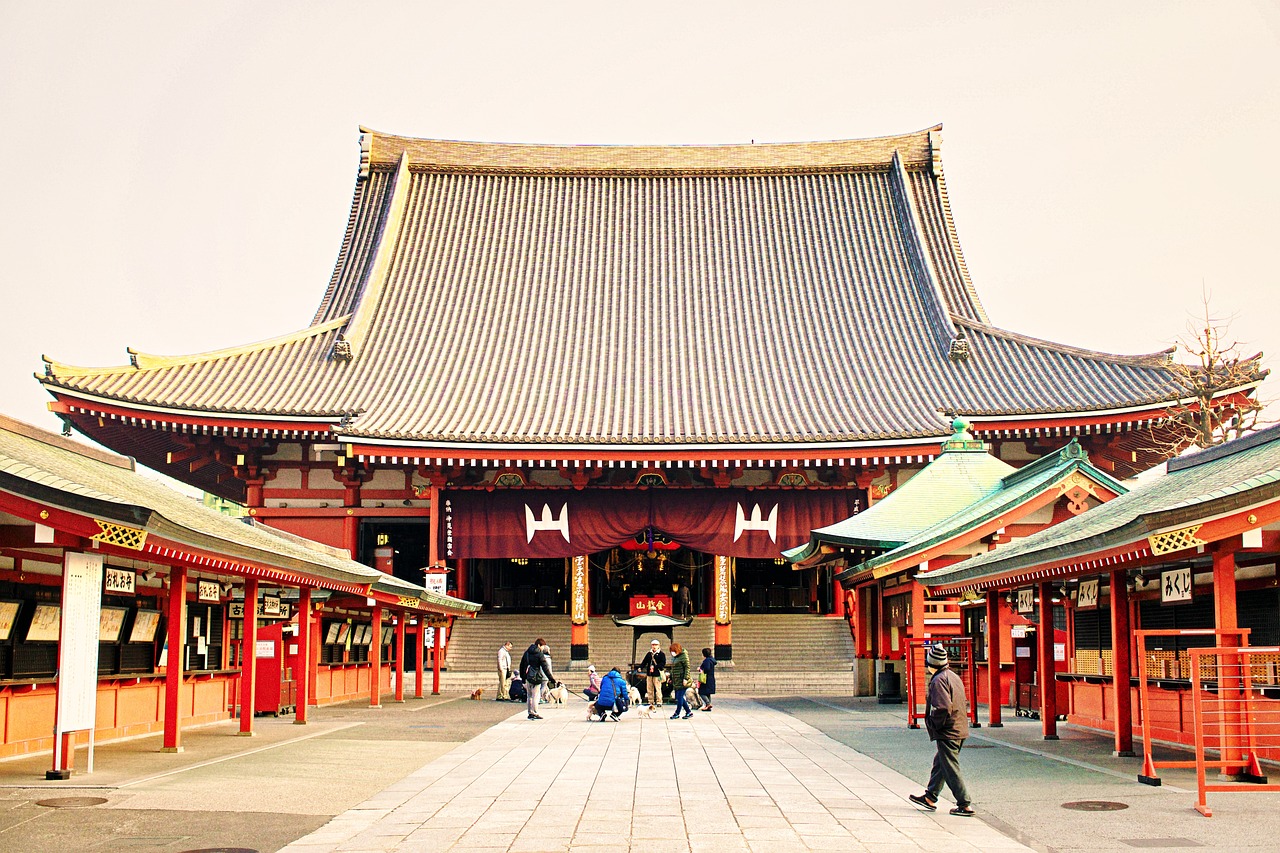
Sensoji Temple, with its nearly 1,400-year history, is a beloved landmark in Tokyo. As the head temple of the Seikannon sect, its main hall enshrines the sacred statue of Kannon Bosatsu (a hidden Buddha). The iconic "Kaminarimon" (Thunder Gate) of Sensoji welcomes visitors with its grand appearance. The large lantern at Kaminarimon is a must-see photo spot for those visiting Asakusa.
Since its founding, Kaminarimon has been destroyed and rebuilt multiple times. The current Kaminarimon, rebuilt in 1960, was donated by Konosuke Matsushita, the founder of Panasonic. The "dragon carvings" on the bottom of the large lantern and the "dragon gods" enshrined behind the statues of the Wind God and Thunder God symbolize the legends associated with dragons at Sensoji. One legend tells of a golden dragon that appeared from the heavens three days after the manifestation of Kannon. Because of this, many dragons are depicted throughout the temple grounds.
While touring Sensoji Temple, one can enjoy finding dragon carvings and paintings in various places, such as the water pavilion, the ceiling of the main hall, and the bottom of the lantern at Hozomon Gate. Exploring the dragon-themed art adds a new layer of enjoyment to the visit.
Additionally, it is recommended to experience the temple at night, when it offers a serene and magical atmosphere different from the bustling daytime. After the shops on Nakamise Street close, a leisurely stroll through the illuminated temple grounds provides a tranquil and unique experience.
Nakamise Street
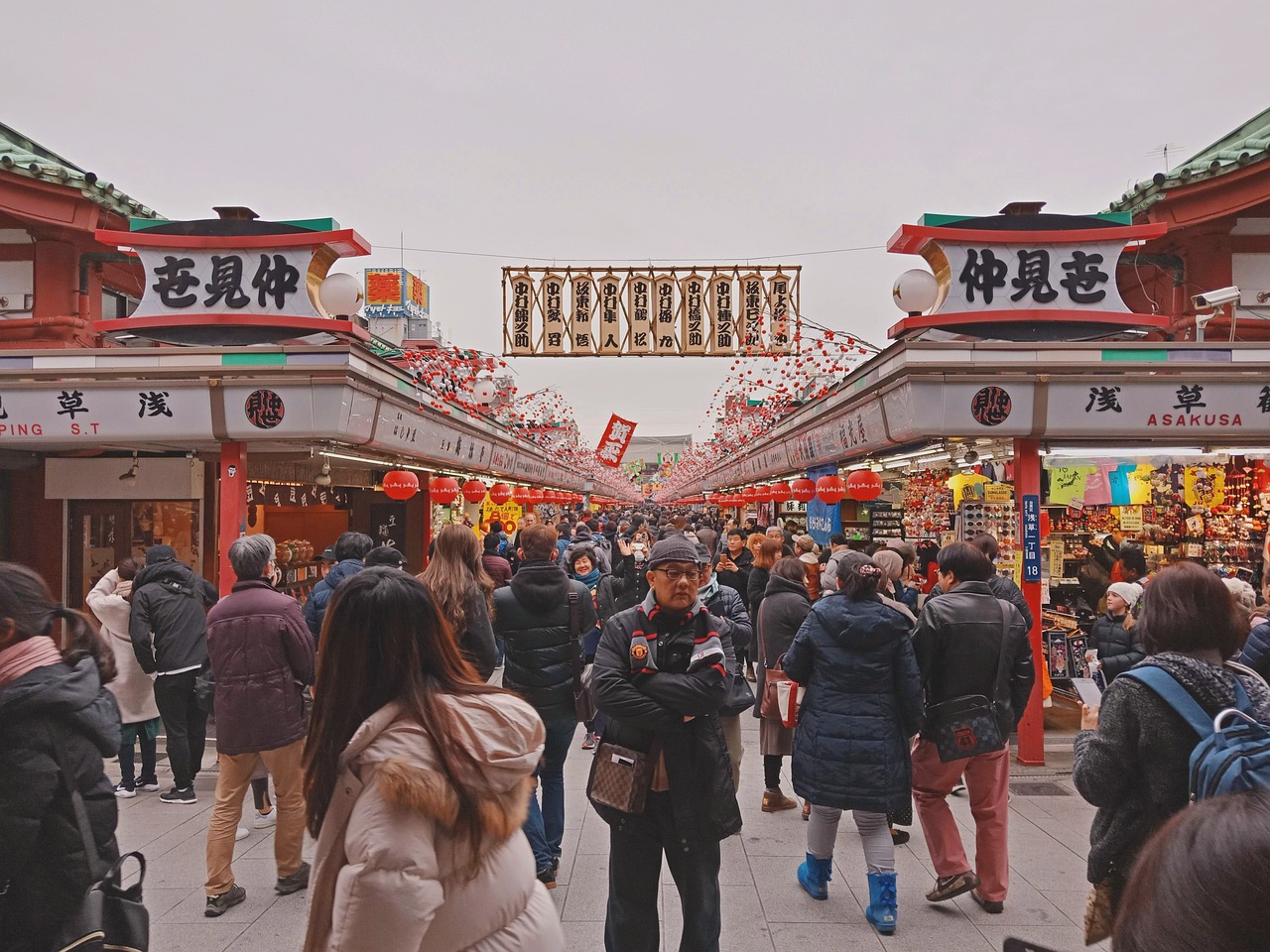
Nakamise Street in Asakusa is one of Tokyo's iconic tourist spots, offering a historic atmosphere that can be felt just by walking through it. Stretching about 250 meters from Kaminarimon Gate to Hozomon Gate, this street is lined with vermilion-painted shops and is known as one of Japan's oldest shopping streets. The name "Nakamise" originates from "Nakamise," meaning the middle point of stores, reflecting its historical evolution over several centuries.
It began with small shops set up under the eaves of sub-temples in the area known as Nanyado of Sensoji Temple, and around 1685, official permission was granted by Sensoji to open stores. With the increasing number of worshippers, the area grew into a bustling shopping street. Nakamise Street offered toys, sweets, souvenirs, and featured the "Nijukken Chaya" near Hozomon Gate, known for its popular beautiful shop girls.
Throughout its history, including significant events like the Great Kanto Earthquake and the Tokyo Air Raids, Nakamise Street has undergone several transformations. The current vermilion-painted shopping street is made of reinforced concrete, taking its present form after post-war restorations. In 1994, further renovations were made, including the removal of utility poles and transitioning to underground wiring, resulting in a tidy, yet vibrant and stylish street.
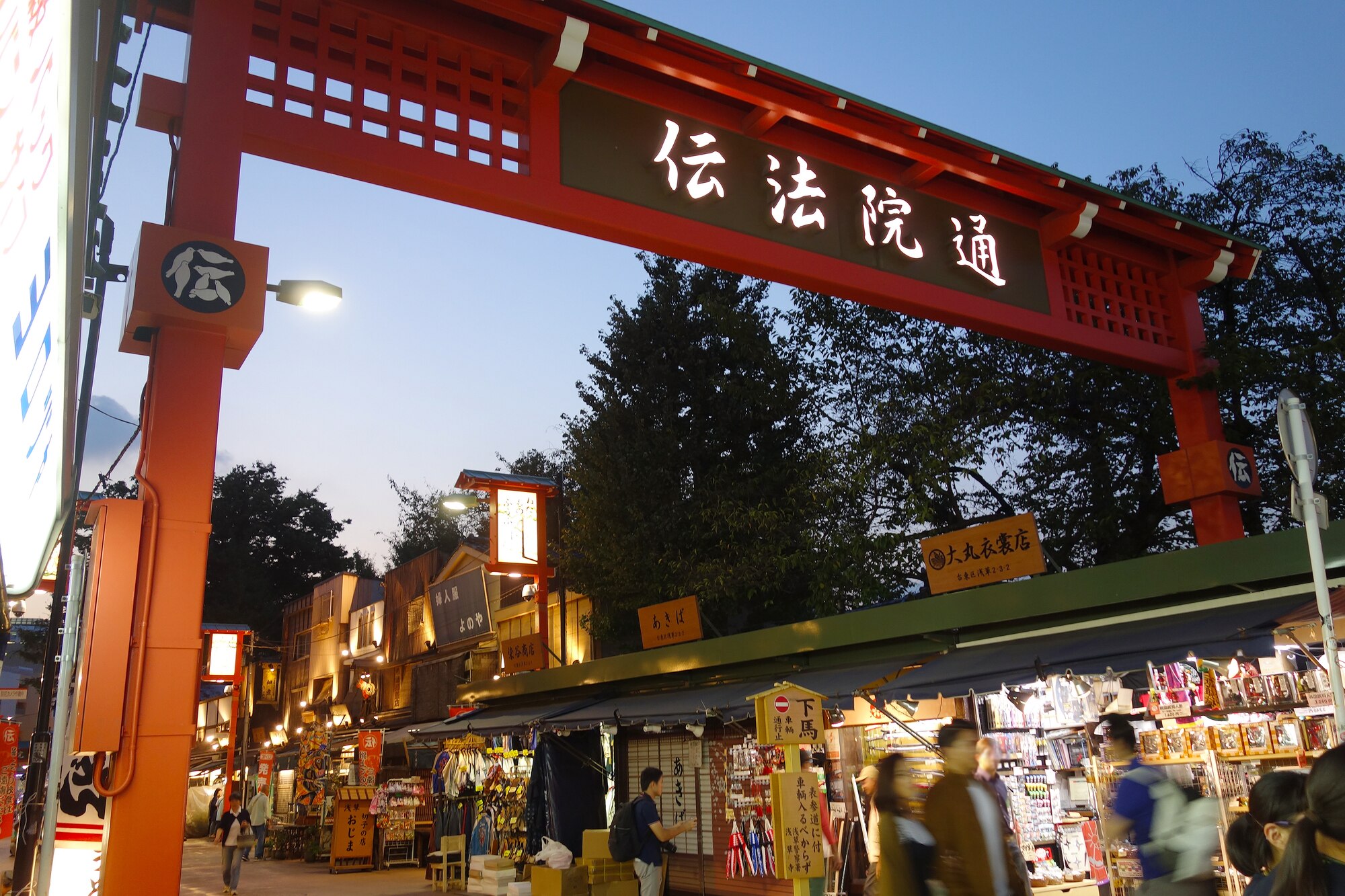
Denboin Street in Asakusa is a charming street located west of Nakamise Street, running about 200 meters in front of the main hall "Denboin" of Sensoji Temple. The gatepost with the sign "Denboin Street" marks the entrance to this street, located midway along Nakamise Street. Denboin Street is known for its unique atmosphere and Edo-period charm, inviting visitors to take a timeless stroll.
The street is lined with stores featuring tiled roofs, evoking the traditional Japanese townscape. Notably, the street is adorned with "Jiguchi Andon" lanterns, which depict puns that were popular during the Edo period, allowing visitors to enjoy their unique expressions as they walk along.
Additionally, on Denboin Street, one might encounter popular characters from kabuki theater such as the heroic thieves "Shiranami Gonin Otoko" (Five Men of the White Waves) and "Nezumi Kozo." These characters symbolize the intersection of traditional Japanese culture and pop culture, enhancing the enjoyment of exploring the street.
(Image Citation: skyticket)
Hanayashiki
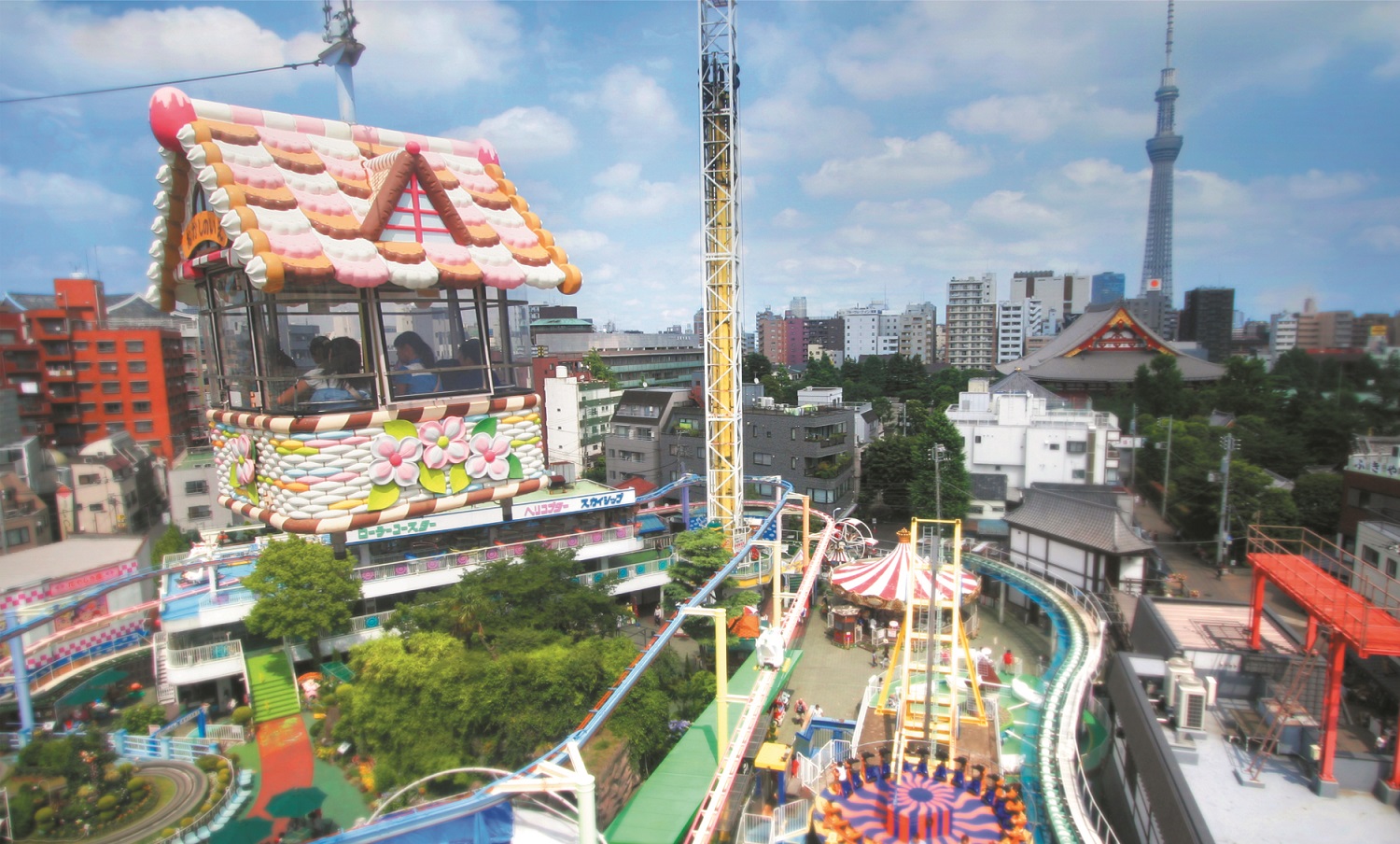
Asakusa Hanayashiki is a historic amusement park with a charm that spans various aspects. Originally located in Okuyama, bustling with visitors to Sensoji Temple during the Edo period, it was a cultural center where street performers gathered, and many theater houses existed. Established in 1853 as a flower garden called "Hanayashiki," it initially spanned 8,000 square meters and displayed flowers such as peonies and chrysanthemums.
Entering the Meiji period, Asakusa Hanayashiki underwent further transformation, adding animal exhibits and amusement facilities, evolving into a place that can be considered the origin of Japanese zoos. In 1887, the five-story Okuyama Pavilion (Phoenix Pavilion) was constructed, with a wooden gold-leaf phoenix placed on its rooftop, becoming a new landmark in Asakusa.
From the Taisho to the early Showa periods, it established itself as one of the leading zoos in the country, but it faced many challenges through the Great Kanto Earthquake and World War II. However, in 1947, it reopened as the amusement park "Asakusa Hanayashiki," starting a new chapter in its history.
Notably, the oldest existing roller coaster in Japan, installed in 1953, remains beloved by many visitors. Additionally, the artificial satellite tower (later Bee Tower), installed in 1960, offers an excellent spot to overlook the town of Asakusa, providing visitors with a special experience.
(Image Citation: 浅草観光連盟)![]()
![]()
Asakusa Trivia
Let's take a look at some trivia about Asakusa. Asakusa has a long history and has experienced many events, so even just the Kaminarimon Gate has various stories. Today, we'll introduce some interesting facts that are worth knowing.
Origin of the Name Asakusa
The name Asakusa first appeared in historical records during the Kamakura period, and there are various theories about its origin. The most widely accepted theory is that it comes from the topography, meaning "a place with shallow grass in Musashino." Other theories suggest it derives from the Ainu word "Atsu-akusa" (meaning "crossing the sea") or the Tibetan word "Asha-kusha" (meaning "a place with saints"), showing a wide range of possible origins.
Origin of the Name Kaminarimon
The Kaminarimon Gate in Asakusa is known for its grand appearance and historical background, attracting many tourists. However, an interesting piece of trivia about this famous gate is that its official name is not actually "Kaminarimon." Officially, it is called "Fujin Raijin-mon" (Wind God and Thunder God Gate). This name originates from the two statues installed at the gate. On the right side of the gate stands the statue of Fujin, the god of wind, and on the left side stands the statue of Raijin, the god of thunder. The gate was named "Fujin Raijin-mon" because it enshrines these two deities. These gods, representing two great forces of nature, have been revered by the Japanese people since ancient times.
Over time, the name "Fujin Raijin-mon" became widely known as the simpler "Kaminarimon." This change reflects the simplification and convenience of everyday language, but the official name holds significance, honoring the importance of each deity and the respect for the natural forces they symbolize.
The Kaminarimon Lantern and Konosuke Matsushita
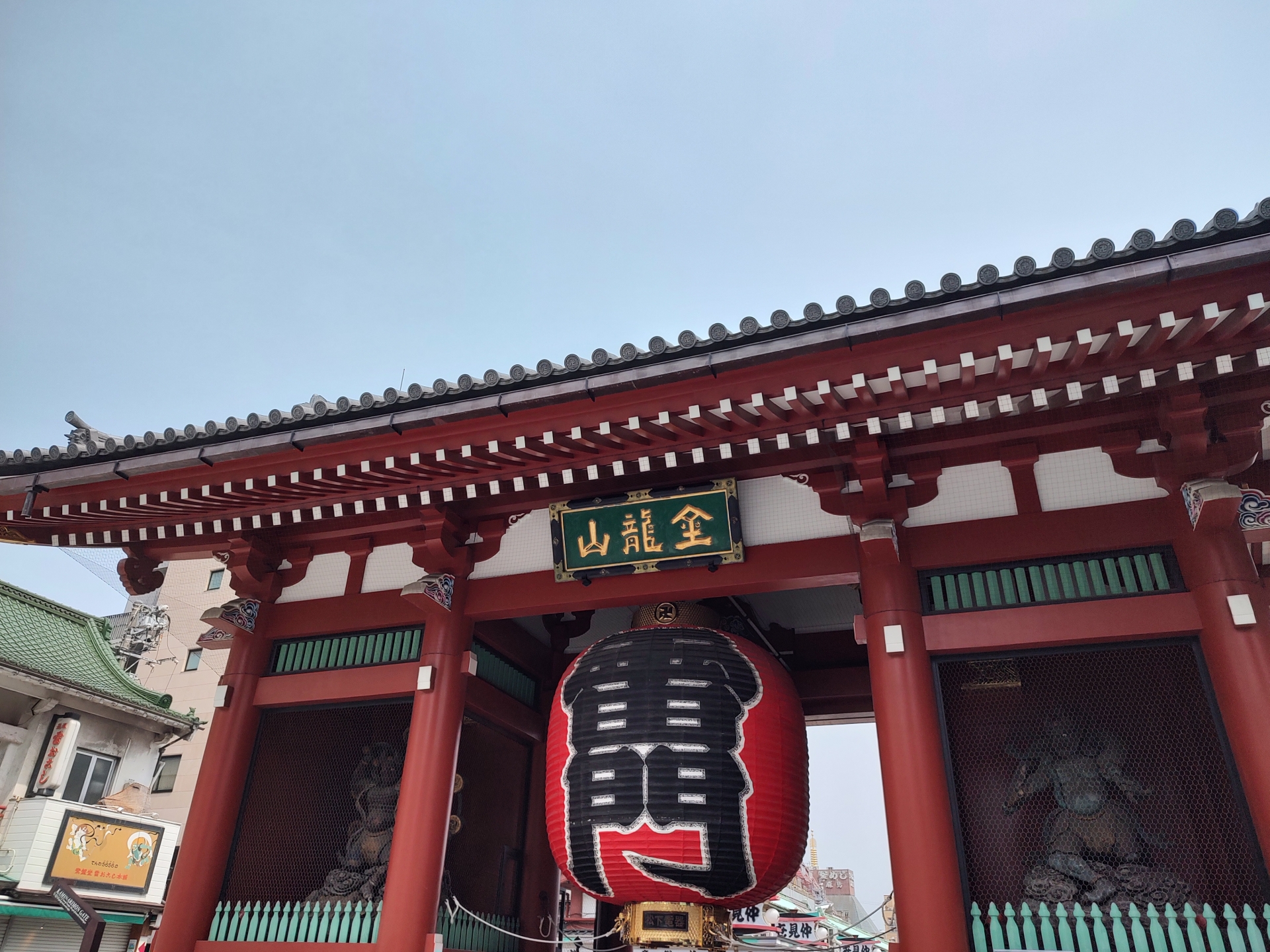
The large lantern at Kaminarimon, a symbol of Asakusa, has a deep connection with the renowned Japanese electronics group Panasonic and its founder, Konosuke Matsushita. This relationship dates back to 1960. At that time, Konosuke Matsushita, who established Matsushita Electric Industrial Co. (now Panasonic), was suffering from a severe illness. Seeking treatment and recovery, he visited Sensoji Temple.
After recovering from his illness, Konosuke Matsushita donated the Kaminarimon Gate and its large lantern to Sensoji Temple as an expression of gratitude. This act led to the creation of the Kaminarimon as we see it today. This gift holds significance beyond mere donation, symbolizing Matsushita's deep respect and gratitude towards Sensoji Temple.
This bond continues to this day, with Konosuke Matsushita’s name inscribed at the bottom of the large lantern. This inscription commemorates the ongoing relationship and contribution of both Konosuke Matsushita and Panasonic to Sensoji Temple, particularly Kaminarimon.
The Dragon Carved on the Kaminarimon Lantern
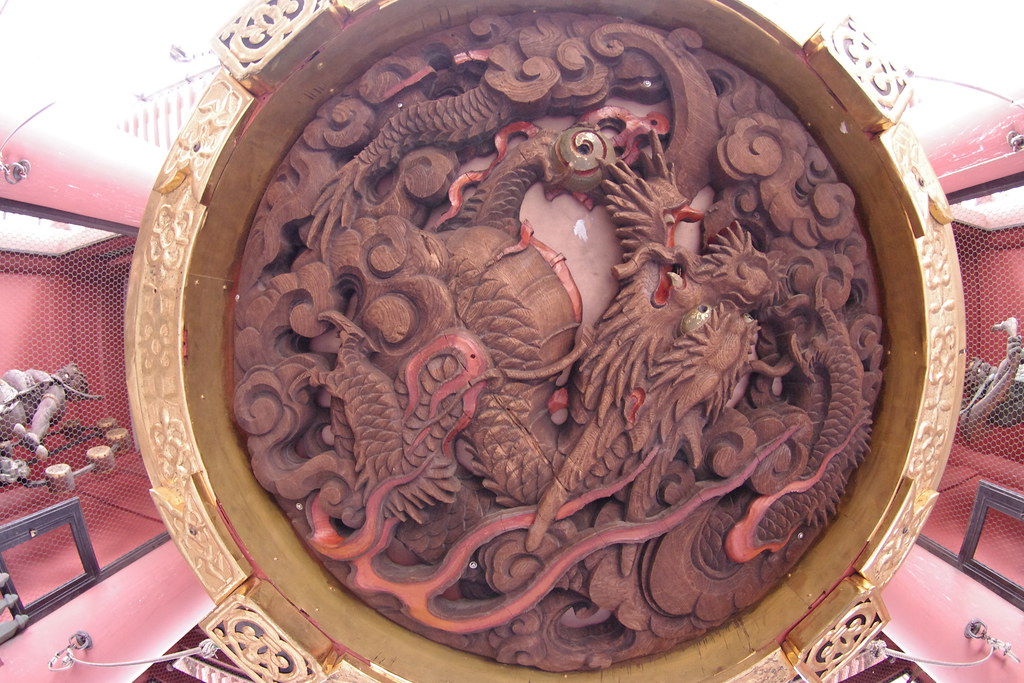
The lantern at Kaminarimon, closely associated with Panasonic, holds significant meaning in the detailed dragon carvings hidden at its base. These carvings depict a dragon motif, serving as one of the deities protecting Sensoji Temple. This dragon carving is based on the legend of the dragon god that appeared with golden scales when a Buddha statue was caught in a net in the Sumida River. This story reflects the faith and culture deeply rooted in Sensoji Temple and its surrounding area, symbolizing the belief that the dragon god watches over this land.
In traditional Japanese belief, dragons residing in the ocean have the power to summon clouds and bring rain. In Asakusa, where wooden buildings were densely packed and prone to fire, the dragon, believed to bring rain and protect people from fires, was considered especially important. This background led to the veneration of the dragon as a dragon god, and its sacred presence is honored through the carvings on the Kaminarimon lantern.
(Image Citation: Flicker)
The Two Statues of Kaminarimon
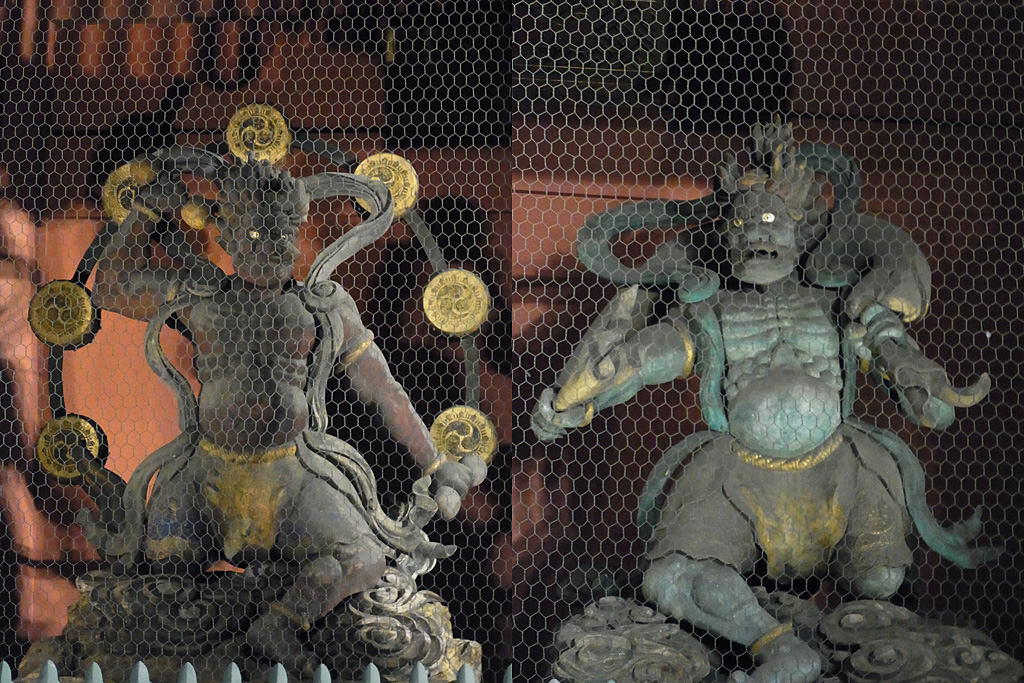
Beyond the Kaminarimon Gate, on the other side, there are hidden treasures that amaze visitors. These are the two statues of the Golden Dragon (a female figure) on the right and the Heavenly Dragon (a male figure) on the left, facing the gate. These statues represent the dragon gods, Golden Dragon and Heavenly Dragon, who are believed to protect Buddhists and govern water. They are symmetrically placed in contrast to the statues of the Wind God and Thunder God, serving as the guardian deities of Sensoji Temple.
According to records passed down at Sensoji Temple, the dragon gods are believed to protect people from sea disasters and ensure the abundant growth of crops. At Sensoji, based on the belief that "dragon gods protect Buddhists," these dragon statues were dedicated as guardian deities of the Kaminarimon Gate. Interestingly, these dragon gods are depicted in human forms, with the Golden Dragon being female and the Heavenly Dragon being male, each with tails that enhance their mystique. This depiction is thought to make the dragon gods more relatable and endearing to people.
Incense Smoke from the Jokoro
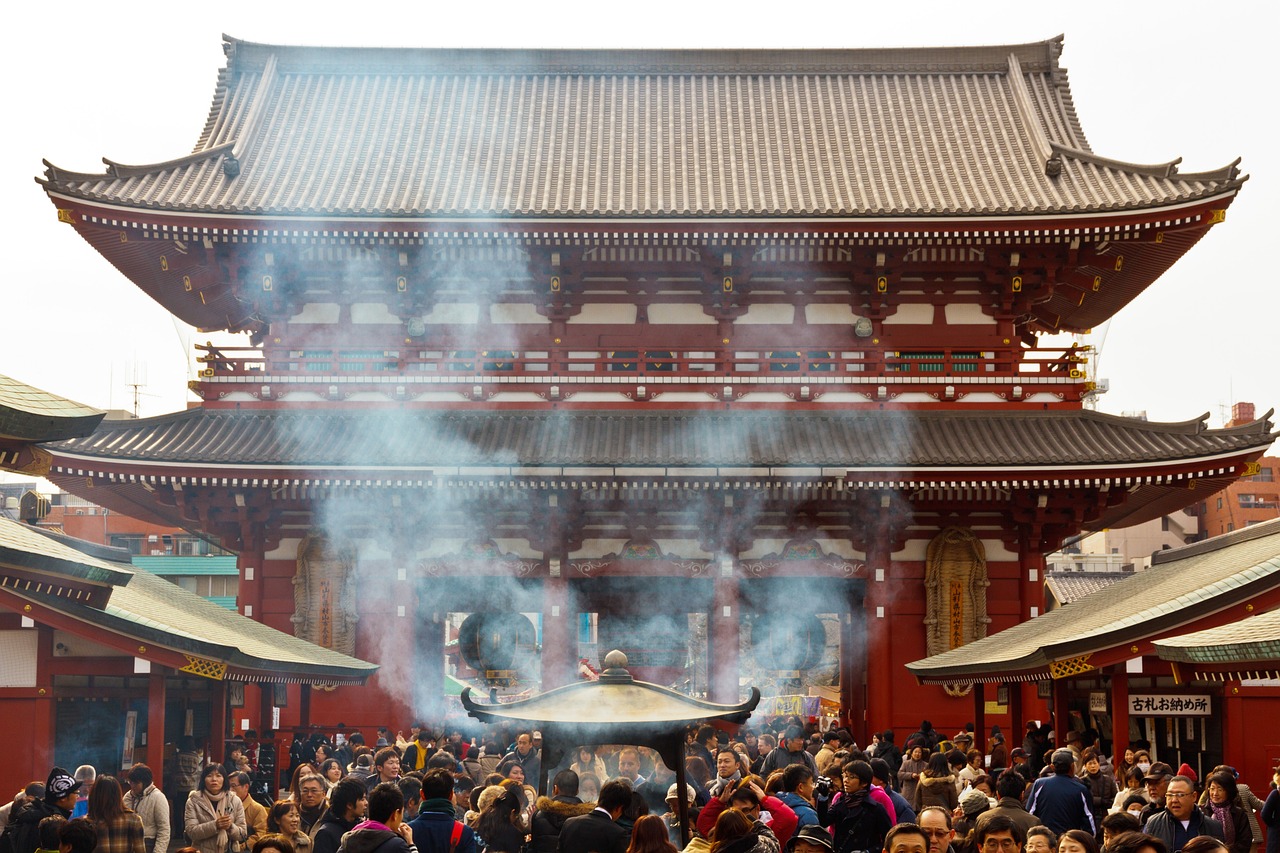
The Jokoro Incense Burner in front of Sensoji Temple is a popular spot with special meaning for many visitors. It is said that the smoke rising from this large ceramic vessel can heal ailments when applied to the body. This practice originates from the use of Chinese incense burners brought to Japan around 400 years ago, during the late Sengoku period. At that time, incense burners were used as Buddhist tools to purify the bodies of worshippers.
Over time, the belief in the healing power of the incense smoke spread, and today it is common to see visitors gathering around the burner and wafting the smoke over their bodies. The smoke from the Jokoro Incense Burner at Sensoji Temple is believed to bring good fortune, and many people cover themselves with the smoke in hopes of improving their health and luck.
Bathing in the smoke from the Jokoro Incense Burner at Sensoji Temple holds more significance than just praying for health. It allows visitors to feel a sense of connection with the temple and experience physical and spiritual purification in accordance with ancient customs. The body part on which the smoke is applied is determined by the individual’s intuition or current feelings. This practice can be seen at temples across Japan, but the Jokoro Incense Burner at Sensoji Temple is particularly famous, attracting many people seeking the benefits of the smoke.
Fortune Slips at Sensoji Temple: More Curses?
One reason the fortune slips (omikuji) at Sensoji Temple draw particular attention from visitors is that they contain a relatively high number of "bad luck" (kyo) fortunes. However, this characteristic has a historical background, setting Sensoji's omikuji apart from those at other locations.
The fortune slips used at Sensoji Temple are part of an ancient system called "Kannon Hyakusen," which is believed to have been widely propagated by Ryogen Sojo (also known as Jikei Daishi or Gensan Daishi) of Enryakuji Temple on Mount Hiei. In this system, the results are specifically distributed as follows: "great blessing (daikichi) 17%, blessing (kichi) 35%, late blessing (suekichi) 6%, half-blessing (hankichi) 5%, small blessing (shokichi) 4%, late small blessing (sue-shokichi) 3%, and curse (kyo) 30%." This distribution forms the distinctive feature of Sensoji’s omikuji.
At many other temples and shrines, the proportion of bad luck slips is reduced to make people feel more optimistic. However, Sensoji Temple maintains this traditional distribution, resulting in a relatively higher proportion of bad luck slips.
Summary
How was it? This time, we have introduced the history, highlights, and trivia of Asakusa. It greatly developed during the Edo period, starting with rice warehouses, and has prospered as a cultural town centered on cinema since the Meiji era. Asakusa has many attractions, and just walking around allows you to experience the history and culture of Japan. Even the Kaminarimon Gate has various origins, so knowing such backgrounds will make your visit to Asakusa even more enjoyable.
Our site also introduces various aspects of Japanese history and culture beyond Asakusa. If you are interested, we would be delighted if you read our other articles as well!



